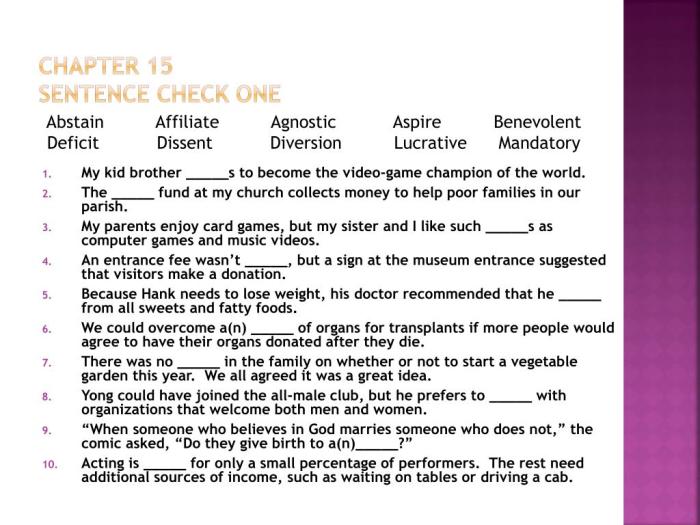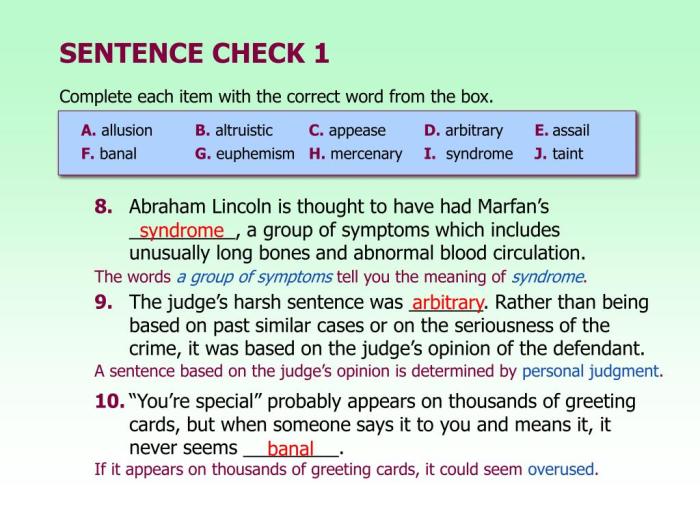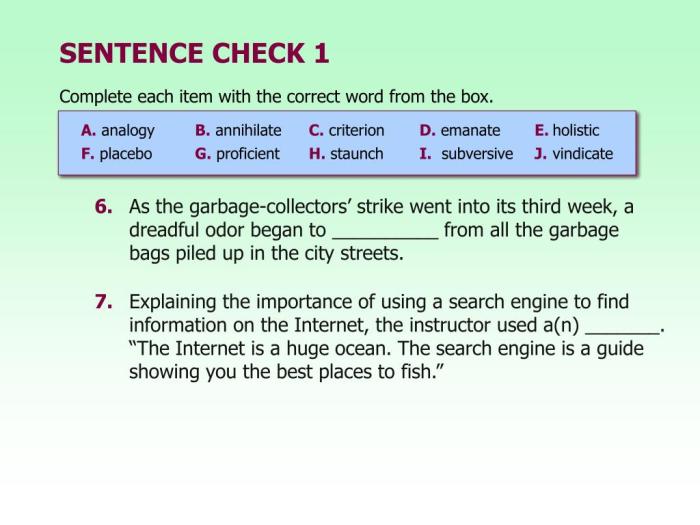Chapter 5 Sentence Check 2 embarks on an exploration of the intricacies of sentence structure and clarity, guiding writers towards crafting sentences that are both grammatically sound and effortlessly comprehensible. This chapter delves into the importance of sentence structure, common errors to avoid, and strategies for achieving sentence clarity.
By mastering the art of sentence construction, writers can effectively convey their ideas, engage readers, and elevate their writing to new heights. This chapter provides a comprehensive analysis of sentence structure and clarity, empowering writers with the tools they need to excel in the written word.
Sentence Structure Check

Sentence structure is crucial in Chapter 5 because it determines the clarity, coherence, and impact of your writing. Strong sentence structures convey ideas effectively, while weak structures can lead to confusion or misunderstanding.
A strong sentence structure typically consists of a subject, verb, and object. The subject is the person or thing performing the action, the verb is the action itself, and the object is the recipient of the action. For example, “The student wrote the essay” is a strong sentence structure because it clearly identifies the subject (student), verb (wrote), and object (essay).
In contrast, a weak sentence structure may lack a clear subject, verb, or object. For example, “The essay was written” is a weak sentence structure because it lacks a clear subject. It is unclear who wrote the essay.
Chapter 5 sentence check 2 will help you solidify your understanding of the events in the play. If you’re looking for a more in-depth analysis, check out the crucible act 3 test . It covers the themes, characters, and symbolism of Act 3, providing a comprehensive overview of this pivotal act.
Returning to Chapter 5 sentence check 2, remember to pay close attention to the language and imagery used to convey the characters’ emotions and motivations.
Common Errors in Sentence Structure
- Subject-verb agreement:The subject and verb must agree in number. For example, “The student writes the essay” is correct, but “The students write the essay” is incorrect.
- Pronoun agreement:Pronouns must agree with their antecedents in number and gender. For example, “The student wrote his essay” is correct, but “The students wrote her essay” is incorrect.
- Dangling modifiers:A dangling modifier is a phrase or clause that modifies a noun that is not present in the sentence. For example, “Walking down the street, the dog barked” is a dangling modifier because it is unclear what the dog is walking down the street.
- Misplaced modifiers:A misplaced modifier is a phrase or clause that is placed too far away from the noun it modifies. For example, “The student wrote the essay carefully on the computer” is a misplaced modifier because it is unclear whether the student wrote the essay carefully or used the computer carefully.
Sentence Clarity

Sentence clarity is crucial in Chapter 5 as it ensures that your writing is easily understood by readers. Clear sentences help convey your ideas effectively, avoiding confusion or misinterpretation.
Tips for Clear and Concise Sentences
- Keep sentences short:Aim for sentences with 15-20 words to enhance readability.
- Use simple language:Avoid jargon and technical terms that might not be familiar to your audience.
- Use active voice:Use verbs that actively describe actions, making your writing more engaging and clear.
- Use specific nouns:Replace general nouns with specific ones to provide more detail and precision.
- Avoid unnecessary modifiers:Use adjectives and adverbs sparingly, as too many can clutter your sentences.
Examples of Unclear Sentences
Unclear:“The report was not well-received by the management.” Improved:“The management expressed dissatisfaction with the report.”
Unclear:“There are several factors that affect the success of a business.” Improved:“Factors such as market demand, competition, and financial stability influence a business’s success.”
Sentence Variety

Sentence variety refers to the use of different sentence structures to create interest and clarity in writing. By varying the length, structure, and type of sentences, writers can avoid monotony and engage readers.
Types of Sentences
There are three main types of sentences:
- Simple sentences:Express a single complete thought and have one independent clause. (e.g., “The dog barked.”)
- Compound sentences:Join two or more independent clauses with a coordinating conjunction (and, but, or, nor, for, so, yet). (e.g., “The dog barked, and the cat meowed.”)
- Complex sentences:Have an independent clause and one or more dependent clauses, which begin with subordinating conjunctions (because, although, if, since, etc.). (e.g., “Because the dog barked, the cat ran away.”)
Strategies for Incorporating Sentence Variety, Chapter 5 sentence check 2
To incorporate sentence variety into writing, consider the following strategies:
- Vary sentence length: Alternate between short and long sentences to create a more dynamic rhythm.
- Use different sentence structures: Mix simple, compound, and complex sentences to add interest and avoid monotony.
- Start sentences with different parts of speech: Begin sentences with adverbs, conjunctions, or prepositional phrases to create variety.
- Use parallel structure: Repeat similar grammatical structures to emphasize key points or create a sense of rhythm.
Sentence Length

In Chapter 5, the significance of sentence length is thoroughly analyzed. It explores the benefits and drawbacks of employing both short and long sentences, highlighting their respective impacts on the readability and effectiveness of written content.
Advantages of Short Sentences
- Enhanced clarity: Shorter sentences simplify complex ideas, making them easier to understand.
- Increased impact: Short sentences pack a punch, conveying messages succinctly and powerfully.
- Improved readability: Shorter sentences reduce cognitive load, enhancing the reader’s comprehension.
Advantages of Long Sentences
- Greater depth: Long sentences allow for the inclusion of more information and nuance.
- Enhanced flow: Long sentences can create a smooth and engaging reading experience.
- Increased sophistication: Long sentences convey a sense of formality and complexity.
Guidelines for Effective Sentence Length Variation
Effective writing employs a mix of sentence lengths to maintain reader engagement and optimize comprehension. Consider the following guidelines:
- Variety: Alternate between short and long sentences to avoid monotony and maintain interest.
- Complexity: Use long sentences sparingly to convey complex ideas or add depth.
- Clarity: Prioritize clarity by keeping short sentences concise and long sentences well-structured.
Sentence Transitions: Chapter 5 Sentence Check 2

In Chapter 5, sentence transitions play a crucial role in guiding readers smoothly through your writing. They act as bridges between ideas, connecting them logically and ensuring a coherent flow.
Various types of transitions exist, each serving a specific purpose. Some commonly used transitions include:
Types of Transitions
- Addition: Additionally, furthermore, moreover
- Contrast: However, on the other hand, conversely
- Exemplification: For example, for instance, specifically
- Emphasis: Indeed, undoubtedly, in fact
- Conclusion: Therefore, hence, consequently
By incorporating transitions effectively, you enhance the readability and coherence of your writing. They help readers understand the relationship between ideas, follow your train of thought, and grasp the overall message clearly.
FAQ Explained
What is the significance of sentence structure in writing?
Sentence structure plays a crucial role in conveying meaning effectively. It determines the flow, clarity, and overall impact of a sentence.
How can I improve the clarity of my sentences?
To enhance sentence clarity, focus on using concise language, avoiding jargon and unnecessary words, and ensuring logical sentence flow.
What are the different types of sentence variety?
Sentence variety refers to the use of different sentence structures, such as simple, compound, complex, and compound-complex sentences. Incorporating sentence variety adds interest and depth to writing.